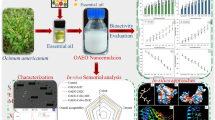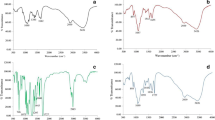Abstract
In vitro antifungal activity of the essential oil from Monarda citriodora (MCEO) with possible mode of action was evaluated against A. flavus (AF-LHP-SH1) and 15 other storage molds for controlling postharvest deterioration of stored functional food samples. The chemical profiling of MCEO as done through GC–MS analysis revealed caryophyllene (19.15%) as the major component. The MCEO showed broad spectrum fungitoxicity and completely inhibited the growth of all tested molds and aflatoxin B1 (AFB1) production by AF-LHP-SH1 at 1.40 and 1.20 µL/mL, respectively. Plasma membrane damage and methylglyoxal inhibition was confirmed as the possible antifungal and antiaflatoxigenic mode of action of MCEO. MCEO exhibited remarkable antioxidant activity with IC50 value 2.24 μL/mL as determined through DPPH assay and did not cause adverse effect on seed germination. In addition, the MCEO was encapsulated into chitosan nanoparticle, characterized (SEM, FTIR, XRD) and assessed for their potential against inhibition of growth and AFB1 production. MCEO after encapsulation exhibited enhanced efficacy inhibiting fungal growth and AFB1 production by AF-LHP-SH1 at 0.6 and 0.5 µL/mL, respectively. Encapsulated MCEO may be recommended as novel preservative to extend the shelf life of stored functional food samples.




Similar content being viewed by others
References
Adams RP (2007) Identification of essential oil components by gas chromatography/mass spectrometry, 4th edn. Allured Publishing Corporation, Carol Stream vol 18, pp 803–806
Alcazar-Fuoli L, Mellado E (2013) Ergosterol biosynthesis in Aspergillus fumigatus: its relevance as an antifungal target and role in antifungal drug resistance. Front Microbiol 3:439
Basak S, Guha P (2017) Use of predictive model to describe sporicidal and cell viability efficacy of betel leaf (Piper betle L.) essential oil on Aspergillus flavus and Penicillium expansum and its antifungal activity in raw apple juice. LWT-Food Sci Technol 80:510–516
Basak S, Guha P (2018) A review on antifungal activity and mode of action of essential oils and their delivery as nano-sized oil droplets in food system. J Food Sci Technol 55:4701–4710
Burt S (2004) Essential oils: their antibacterial properties and potential applications in foods—a review. Int J Food Microbiol 94:223–253
Chaudhari AK, Singh A, Singh VK, Dwivedy AK, Das S, Ramsdam MG, Dubey NK (2019) Assessment of chitosan biopolymer encapsulated α-Terpineol against fungal, aflatoxin B1 (AFB1) and free radicals mediated deterioration of stored maize and possible mode of action. Food Chem. https://doi.org/10.1016/j.foodchem.2019.126010
Chen ZY, Brown RL, Rajasekaran K, Damann KE, Cleveland TE (2006) Identification of a maize kernel pathogenesis-related protein and evidence for its involvement in resistance to Aspergillus flavus infection and aflatoxin production. Phytopathology 96:87–95
da Silva Gündel S, Velho MC, Diefenthaler MK, Favarin FR, Copetti PM, de Oliveira Fogaça A, Ourique AF (2018) Basil oil-nanoemulsions: development, cytotoxicity and evaluation of antioxidant and antimicrobial potential. J Drug Deliv Sci Technol 46:378–383
Dorman HD, Deans SG (2004) Chemical composition, antimicrobial and in vitro antioxidant properties of Monarda citriodora var. citriodora, Myristica fragrans, Origanum vulgare ssp. Hirtum, Pelargonium sp. and Thymus zygis oils. J Essent Oil Res 16:145–150
Dwivedy AK, Prakash B, Chanotiya CS, Bisht D, Dubey NK (2017) Chemically characterized Mentha cardiaca L. essential oil as plant based preservative in view of efficacy against biodeteriorating fungi of dry fruits, aflatoxin secretion, lipid peroxidation and safety profile assessment. Food Chem Toxicol 106:175–184
Dwivedy AK, Singh VK, Prakash B, Dubey NK (2018) Nanoencapsulated Illicium verum Hook. f. essential oil as an effective novel plant-based preservative against aflatoxin B1 production and free radical generation. Food Chem Toxicol 111:102–113
Ferreira FMD, Hirooka EY, Ferreira FD, Silva MV, Mossini SAG, Machinski M Jr (2018) Effect of Zingiber officinale Roscoe essential oil in fungus control and deoxynivalenol production of Fusarium graminearum Schwabe in vitro. Food Addit Contam A 1:7
Gago CML, Artiga-Artigas M, Antunes MDC, Faleiro ML, Miguel MG, Martín-Belloso O (2019) Effectiveness of nanoemulsions of clove and lemongrass essential oils and their major components against Escherichia coli and Botrytis cinerea. J Food Sci Technol 56:2721–2736
Gholivand MB, Rahimi-Nasrabadi M, Batooli H, Ebrahimabadi AH (2010) Chemical composition and antioxidant activities of the essential oil and methanol extracts of Psammogeton canescens. Food Chem Toxicol 48:24–28
Gilman JC, Joseph C (1998) A manual of soil fungi, 1st edn. Daya Books, New Delhi
Haider J, Majeed H, Williams PA, Safdar W, Zhong F (2017) Formation of chitosan nanoparticles to encapsulate krill oil (Euphausia superba) for application as a dietary supplement. Food Hydrocolloid 63:27–34
Hosseini SF, Zandi M, Rezaei M, Farahmandghavi F (2013) Two-step method for encapsulation of oregano essential oil in chitosan nanoparticles: preparation, characterization and in vitro release study. Carbohydr Polym 95:50–56
Jayashree T, Subramanyam C (2000) Oxidative stress as a prerequisite for aflatoxin production by Aspergillus parasiticus. Free Rad Biol Med 29:981–985
Jingou J, Shilei H, Weiqi L, Danjun W, Tengfei W, Yi X (2011) Preparation, characterization of hydrophilic and hydrophobic drug in combine loaded chitosan/cyclodextrin nanoparticles and in vitro release study. Colloid Surf B 83:103–107
Kalapos MP (2008) The tandem of free radicals and methylglyoxal. Chem-Biol Interact 171:251–271
Kedia A, Prakash B, Mishra PK, Chanotiya CS, Dubey NK (2014) Antifungal, antiaflatoxigenic, and insecticidal efficacy of spearmint (Mentha spicata L.) essential oil. Int Biodeter Biodegr 89:29–36
Khan A, Ahmad A, Akhtar F, Yousuf S, Xess I, Khan LA, Manzoor N (2010) Ocimum sanctum essential oil and its active principles exert their antifungal activity by disrupting ergosterol biosynthesis and membrane integrity. Res Microbiol 161:816–823
Kohiyama CY, Ribeiro MMY, Mossini SAG, Bando E, da Silva Bomfim N, Nerilo SB, Machinski M Jr (2015) Antifungal properties and inhibitory effects upon aflatoxin production of Thymus vulgaris L. by Aspergillus flavus Link. Food Chem 173:1006–1010
Kong J, Zhang Y, Ju J, Xie Y, Guo Y, Cheng Y, Yao W (2019) Antifungal effects of thymol and salicylic acid on cell membrane and mitochondria of Rhizopus stolonifer and their application in postharvest preservation of tomatoes. Food Chem 285:380–388
Kumar M, Sarma P, Dkhar MS, Kayang H, Raghuwanshi R, Dubey NK (2018) Assessment of chemically characterised Gaultheria fragrantissima Wall. essential oil and its major component as safe plant based preservative for millets against fungal, aflatoxin contamination and lipid peroxidation during storage. J Food Sci Technol 55:111–119
Lobo V, Patil A, Phatak A, Chandra N (2010) Free radicals, antioxidants and functional foods: impact on human health. Pharmacog Rev 4:118
Lu ZG, Li XH, Li W (2011) Chemical composition of antibacterial activity of essential oil from Monarda citriodora flowers. Adv Mat Res 183:920–923
Maryam I, Huzaifa U, Hindatu H, Zubaida S (2015) Nanoencapsulation of essential oils with enhanced antimicrobial activity: A new way of combating antimicrobial Resistance. J Pharma Phytochem 4:165
Prakash B, Kedia A, Singh A, Yadav S, Singh A, Yadav A, Dubey NK (2016) Antifungal, antiaflatoxin and antioxidant activity of plant essential oils and their in vivo efficacy in protection of chickpea seeds. J Food Quality 39:36–44
Rawat S (2015) Food Spoilage: microorganisms and their prevention. Asian J Plant Sci Res 5:47–56
Shojaee-Aliabadi S, Hosseini H, Mohammadifar MA, Mohammadi A, Ghasemlou M, Hosseini SM, Khaksar R (2014) Characterization of κ-carrageenan films incorporated plant essential oils with improved antimicrobial activity. Carbohydr Polym 101:582–591
Silva KP, de Carvalho Santos TA, Moutinho BL, da Silva RS, dos Santos Pinto V, Blank AF, Fernandes RPM (2019) Using Varronia curassavica (Cordiaceae) essential oil for the biocontrol of Phytomonas serpens. Ind Crop Prod 139:111523
Singh P, Srivastava B, Kumar A, Dubey NK (2008) Fungal contamination of raw materials of some herbal drugs and recommendation of Cinnamomum camphora oil as herbal fungitoxicant. Microb Ecol 56:555–560
Tian J, Ban X, Zeng H, He J, Chen Y, Wang Y (2012a) The mechanism of antifungal action of essential oil from dill (Anethum graveolens L.) on Aspergillus flavus. PLoS ONE 7:e30147
Tian J, Huang B, Luo X, Zeng H, Ban X, He J, Wang Y (2012b) The control of Aspergillus flavus with Cinnamomum jensenianum Hand.-Mazz essential oil and its potential use as a food preservative. Food Chem 130:520–527
Upadhyay N, Singh VK, Dwivedy AK, Das S, Chaudhari AK, Dubey NK (2018) Cistus ladanifer L. essential oil as a plant based preservative against molds infesting oil seeds, aflatoxin B1 secretion, oxidative deterioration and methylglyoxal biosynthesis. LWT-Food Sci Technol 92:395–403
USEPA (United States Environment Protection Agency) (1993) R.E.D. FACTS. Flower and Vegetable Oils. at http://www.epa.gov/oppsrrd1/REDs/factsheets/4097fact.pdf. Accessed 2 Feb 2008)
USFDA (2013) GRAS notice inventory. GRN, No. 397, www.fda.gov
Xu T, Gao C, Feng X, Huang M, Yang Y, Shen X, Tang X (2019) Cinnamon and clove essential oils to improve physical, thermal and antimicrobial properties of chitosan-gum arabic polyelectrolyte complexed films. Carbohydr Polym 217:116–125
Yadav SK, Singla-Pareek SL, Ray M, Reddy MK, Sopory SK (2005) Methylglyoxal levels in plants under salinity stress are dependent on glyoxalase I and glutathione. Biochem Bioph Res Co 337:61–67
Yoksan R, Jirawutthiwongchai J, Arpo K (2010) Encapsulation of ascorbyl palmitate in chitosan nanoparticles by oil-in-water emulsion and ionic gelation processes. Colloid Surf B 76:292–297
Zhang H, Yang S, Fang J, Deng Y, Wang D, Zhao Y (2014) Optimization of the fermentation conditions of Rhizopus japonicus M193 for the production of chitin deacetylase and chitosan. Carbohydr Polym 101:57–67
Acknowledgement
Deepika is thankful to the University Grants Commission (UGC) [Grant No. F.16-6 (DEC. 2016)/2017] New Delhi, India for financial support. Authors are thankful to Head, CAS in Botany, DST-PURSE, ISLS, Banaras Hindu University, Varanasi for laboratory providing laboratory facility and Indian Institute of Technology, Banaras Hindu University for HR–SEM, FTIR and XRD analysis.
Author information
Authors and Affiliations
Corresponding author
Ethics declarations
Conflict of interest
The authors declare that they have no conflict of interest.
Additional information
Publisher's Note
Springer Nature remains neutral with regard to jurisdictional claims in published maps and institutional affiliations.
Electronic supplementary material
Below is the link to the electronic supplementary material.
Rights and permissions
About this article
Cite this article
Deepika, Singh, A., Chaudhari, A.K. et al. Nanoencapsulated Monarda citriodora Cerv. ex Lag. essential oil as potential antifungal and antiaflatoxigenic agent against deterioration of stored functional foods. J Food Sci Technol 57, 2863–2876 (2020). https://doi.org/10.1007/s13197-020-04318-4
Revised:
Accepted:
Published:
Issue Date:
DOI: https://doi.org/10.1007/s13197-020-04318-4




